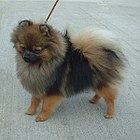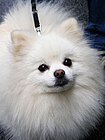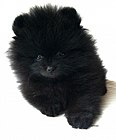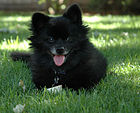How Long Do Toy Pomeranians Live
| Pomeranian | |||||||||||||||||
|---|---|---|---|---|---|---|---|---|---|---|---|---|---|---|---|---|---|
 | |||||||||||||||||
| Other names | Deutscher Spitz, Zwergspitz, Dwarf Spitz | ||||||||||||||||
| Common nicknames | Pom Dog, Pom-Pom, Pom, Zwers, Tumbleweed | ||||||||||||||||
| Origin | Pomerania | ||||||||||||||||
| |||||||||||||||||
| |||||||||||||||||
| Dog (domestic domestic dog) | |||||||||||||||||
The Pomeranian (often known equally a Pom) is a breed of dog of the Spitz type that is named for the Pomerania region in due north-west Poland and north-eastward Deutschland in Central Europe. Classed equally a toy dog breed because of its small size, the Pomeranian is descended from larger Spitz-type dogs, specifically the German Spitz. Information technology has been determined by the Fédération Cynologique Internationale to be part of the German Spitz brood; and in many countries, they are known equally the Zwergspitz ("Dwarf Spitz").
The brood has been fabricated popular by a number of royal owners since the 18th century. Queen Victoria owned a particularly minor Pomeranian and consequently, the smaller variety became universally pop. During Queen Victoria's lifetime lone, the size of the breed decreased by half. Overall, the Pomeranian is a sturdy, good for you dog. The almost mutual health problems are luxating patella and tracheal plummet. More than rarely, the breed tin can have Alopecia X, a peel condition colloquially known as "blackness peel affliction". This is a genetic disease which causes the dog's skin to plough black and lose all or most of its hair.[1] As of 2017, in terms of registration figures, since at to the lowest degree 1998, the brood has ranked among the top fifty virtually popular breeds in the Usa, and the current mode for small-scale dogs has increased their popularity worldwide.
Appearance
Pomeranians are pocket-size dogs weighing one.36–3.17 kilograms (3.0–7.0 lb) and standing 8–14 inches (xx–36 cm) high at the withers.[2] They are compact just sturdy dogs with an abundant textured coat with a highly plumed tail set high and apartment.[3] The top glaze forms a ruff of fur on the neck, which Poms are well known for, and they also have a fringe of feathery hair on the hindquarters.[4]
The earliest examples of the breed were white or occasionally brown or blackness. Queen Victoria adopted a small cerise Pomeranian in 1888, which caused that colour to become stylish by the end of the 19th century.[5] In modern times, the Pomeranian comes in the widest variety of colors of any dog breed, including white, black, brown, cherry, orange, cream, blueish, sable, black and tan, brown and tan, spotted, brindle, and parti, plus combinations of those colors.[6] The nigh common colors are orange, black, or foam/white.[3]
The merle Pomeranian is a contempo colour adult past breeders. It is a combination of a solid base colour with a lighter bluish/grey patch which gives a mottled effect. The most common base colours for the effect are red/brown or black, although it tin can as well announced with other colours. Combinations such equally brindle merle or liver merle are not accepted in the breed standard. In add-on, the eye, olfactory organ and paw pad are marshmallow colour, changing parts of the eye to blue and the color on the nose and paw pads to go mottled pink and black.[7]
Pomeranians have a thick double coat. While grooming is not difficult, breeders recommend that it exist done daily to maintain the quality of the glaze and because of its thickness and the constant shedding, with trimming every 1–2 months. The outer coat is long, straight, and harsh in texture while the undercoat is soft, thick and short. The coat knots and tangles easily, particularly when the undercoat is existence shed, which happens twice a twelvemonth.[8]
-

Cream-colored Pomeranian
-

Orangish sable Pomeranian
-

Tri-colored Pomeranian
-

A white Pomeranian
-

Reddish Sable Pomeranian
-

Full-grown Pomeranian
-

Black Pomeranian puppy
-

Black Pomeranian
-

Toy-sized Pomeranian
-

White Pomeranian
Behavior

Pomeranians are typically friendly, lively and playful. They tin can be aggressive with other dogs and humans to try to testify themselves.[9] [10] Pomeranians are alert and aware of changes in their environs, and barking at new stimuli can develop into a habit of barking excessively in any situation. They are somewhat defensive of their territory and thus may bark when they hear outside noises.[11] Pomeranians are intelligent, respond well to grooming, and can exist very successful in getting what they want from their owners. They are extroverted and enjoy being the center of attention, but they can become ascendant, willful and stubborn if not well trained and socialized. The use of toys can be an effective tool in training Pomeranians to spend time solitary.
Health
The life expectancy of a Pomeranian is 12 to 16 years.[12] [ better source needed ] A well-bred dog on a expert diet with appropriate exercise will have few health problems; if kept trim and fit, the Pomeranian is a sturdy domestic dog.[13] The breed does accept similar health bug to many other canis familiaris breeds, although some issues such as hip dysplasia are uncommon because of the Pomeranian's lightweight build.[fourteen] Some wellness problems tin can develop as a outcome of lack of attention to grooming and teeth-, ear-, and center-cleaning. With routine care, these problems tin be avoided.[fifteen] They are prone to early tooth loss, and dry nutrient is recommended.[16] Poms are one of the breeds with the smallest average litter size, with diverse sources giving numbers of between 1.9 and 2.7 puppies per litter.[17]
Mutual bug
Merle-colored dogs may have mild to severe deafness, incomprehension, increased intraocular pressure, ametropia, microphthalmia, and colobomas. Merle dogs built-in from parents who are also both merles may additionally accept abnormalities of the skeletal, cardiac and reproductive systems.[18]
Luxating patella is some other health issue in the Pomeranian breed.[xiv] It occurs when, either through malformation or trauma, the ridges forming the patellar groove in the knee are non prominent and are too shallow to allow the patella to properly sit deeply. This can crusade the patella to "luxate" (jump out of the groove) sideways, which will cause the leg to lock upwards with the foot off the ground.[nineteen] While the muscles are contracted the patella cannot return to the correct position. The initial pain is caused by the articulatio genus cap sliding across the ridges of the femur. Once out of position, the dog does not feel any pain caused by the slipped bone.[nineteen]
Tracheal collapse is caused past a weakening of the tracheal rings in the windpipe. Information technology occurs when the rings that normally hold the shape of the windpipe collapse, endmost the airway. The symptoms of a collapse include a honking coughing that can sound similar to a goose honk, an intolerance to practice, fainting spells and a coughing that is worsened by hot weather, practice and excitement.[20] The tendency for episodes of tracheal collapse typically increases in frequency and severity as the dog ages.
In Pomeranians, a condition often called "blackness skin disease" occurs which is a combination of baldness (hair loss) and hyperpigmentation (a darkening of the skin).[21] Other names for this condition include woolly glaze, glaze funk, pseudo-Cushing'due south disease, or severe pilus loss syndrome. This condition affects male Pomeranians more than females, and may be inherited.[i] Although most affected dogs show signs following puberty, it tin can occur at any age. Other conditions tin can mimic this condition including Cushing'south syndrome, hypothyroidism, chronic skin infections, and reproductive hormone disorders.[1]
Another mutual disorder in male person Pomeranians is cryptorchidism.[22] This is when either one or both of the testicles practice non descend into the scrotum.[22] It is treated through surgical removal of the retained testicle.[22]
Practise
The Pomeranian is a pocket-size but energetic breed of dog. Although Pomeranians benefit from frequent attending, they need relatively little practice: it is recommended to have them on several daily walks and let them run around an enclosed space.[23]
History
Origins

A miniature Pomeranian from 1915
The Pomeranian is considered to be descended from the German Spitz.[24] The breed is idea to have caused its name past association with the expanse known as Pomerania which is located in northern Poland and Germany along the Baltic Body of water. Although not the origin of the breed, this area is credited with the breeding which led to the original Pomeranian type of dog. Proper documentation was lacking until the breed'south introduction into the United Kingdom.[24]

Portrait of Mr and Mrs William Hallett by Thomas Gainsborough, 1785. The painting features a larger type of Pomeranian than is now common.
An early modern recorded reference to the Pomeranian breed is from ii November 1764, in a diary entry in James Boswell'southward Boswell on the Grand Tour: Germany and Switzerland. "The Frenchman had a Pomeranian canis familiaris named Pomer whom he was mighty fond of."[25] The offspring of a Pomeranian and a wolf bred by an animal merchant from London is discussed in Thomas Pennant's A Tour in Scotland from 1769.[26]
Two members of the British Purple Family influenced the evolution of the breed. In 1767, Queen Charlotte, Queen-consort of Male monarch George III of Great U.k., brought two Pomeranians to England.
Named Phoebe and Mercury, the dogs were depicted in paintings by Sir Thomas Gainsborough. These paintings depicted a domestic dog larger than the modern breed, reportedly weighing as much equally xxx–50 lb (14–23 kg), but showing mod traits such as the heavy coat, ears and a tail curled over the back.[24]
Queen Victoria, Queen Charlotte's granddaughter, was also an enthusiast and established a big breeding kennel. One of her favoured dogs was a comparatively small cherry-red sable Pomeranian which she peradventure named "Windsor'southward Marco" and was reported to weigh simply 12 lb (5.4 kg). When she first exhibited Marco in 1891, it caused the smaller-type Pomeranian to go immediately popular and breeders began selecting simply the smaller specimens for convenance. During her lifetime, the size of the Pomeranian breed was reported to take decreased by 50%.[24] Queen Victoria worked to improve and promote the Pomeranian breed past importing smaller Pomeranians[27] of different colours from diverse European countries to add to her breeding program.[28] Royal owners during this period also included Joséphine de Beauharnais, the wife of Napoleon I of France, and Male monarch George Iv of the Britain.
The first brood club was set in England in 1891, and the offset breed standard was written shortly afterwards.[29] The first member of the brood was registered in the United States to the American Kennel Club in 1898, and it was recognized in 1900.[24]
In 1912, 2 Pomeranians were among only three dogs to survive the sinking of RMS Titanic. A Pomeranian called "Lady", owned by Miss Margaret Hays, escaped with her owner in lifeboat number seven, while Elizabeth Barrett Rothschild took her pet to safety with her in lifeboat number half-dozen.[30]
Glen Rose Flashaway won the Toy Group at the Westminster Kennel Club Canis familiaris Show in 1926, the first Pomeranian to win a group at Westminster.[24] It would take until 1988 for the first Pomeranian, "Bang-up Elms Prince Mannerly II", to win the Best in Show prize from the Westminster Kennel Club.[31]
In the standard published in 1998, the Pomeranian is included in the German Spitz standard, along with the Keeshond, past the Fédération Cynologique Internationale.[32] Co-ordinate to the standard "Spitz breeds are captivating" and have a "unique feature, cheeky appearance."[32]
Popularity
The Pomeranian has been among the more than popular canis familiaris breeds in the United States, featuring consistently in the height 20 of registered American Kennel Club dog breeds since at least 1998, when it was ranked #10; the brood was #17 in the 2011 rankings, dropping two spots from the previous year.[33] In 2012 and 2013 it remained in the pinnacle 20 and was ranked at #xix.[34] In 2015, the breed fell to #21, falling further to #22 in both 2016 and 2017.[35]
It is not listed in the superlative xx breeds in the United kingdom in either 2007 or 2008.[36] In Australia their popularity has declined since 1986, with a superlative of one,128 Pomeranians registered with the Australian National Kennel Quango in 1987; only 577 were registered in 2008. However, this is an increment from 2004, when only 491 dogs were registered. It is recognised that the mutual Pomeranian is listed as the 27th almost intelligent dog with the German Shepherd sitting at no i. [37]
It is more popular in American cities in 2008, ranking articulation tenth (with the American Bulldog) in Detroit[38] and Orlando,[39] ninth in Los Angeles,[forty] a articulation 7th in Seattle (again, with the American Bulldog),[41] but third in Honolulu, just bested by the Labrador Retriever and the High german Shepherd.[38]
See also
- Companion dog
- Boo (dog)
- Lap dog
- Missile (Ghost Trick)
- Therapy dog
References
- ^ a b c "BSD (Black Skin Illness) Alopecia X, Coat Funk". Pommania Pomeranians. Retrieved 30 Nov 2009.
- ^ Cunliffe, Juliette (1999). The Encyclopedia of Domestic dog Breeds. Parragon. p. 262. ISBN978-0-7525-8018-0.
- ^ a b Unhurt, Rachael (2008). Dogs: 101 Adorable Breeds. Andrews McMeel. p. 197. ISBN978-0-7407-7342-6.
- ^ "Pomeranian History". Premier Pomeranians. Archived from the original on 15 July 2011. Retrieved iv December 2009.
- ^ "What is a Pomeranian". Web Answers. Archived from the original on 28 July 2011. Retrieved 2 Feb 2010.
- ^ Coile, D. Caroline (2007). Pomeranians for Dummies. For Dummies. p. 29. ISBN978-0-470-10602-0.
- ^ "Merle Pomeranians". Merle Pomeranians. Archived from the original on 5 August 2010. Retrieved six December 2009.
- ^ Dane Stanton (2009). "Tips on Pomeranian Preparation". Pomeranian Dogs. Archived from the original on 16 March 2010. Retrieved 2 February 2010.
- ^ "Pomeranian Guide". animal.discovery.com. Archived from the original on fifteen Oct 2011. Retrieved 25 August 2013.
- ^ "Pomeranian - Temperament & Personality". petwave.com. Archived from the original on 22 March 2018. Retrieved 30 November 2014.
- ^ "A Pup For Christmas". The Sydney Forenoon Herald. 25 November 1974. Retrieved 29 January 2014.
- ^ "Pomeranian Information". PomPom.com. Archived from the original on 29 December 2010. Retrieved 30 Nov 2009.
- ^ "Pomeranian Health Direction". My Dog Brood: The Pomeranian. Archived from the original on fourteen July 2011. Retrieved 2 Feb 2010.
- ^ a b "Pomeranian Health Problems". Archived from the original on 14 July 2011. Retrieved thirty Nov 2009.
- ^ "Pomeranian Health: Caring For Your Pomeranian". Pomeranian Dogs. Archived from the original on seven November 2009. Retrieved 2 February 2010.
- ^ "Dogs 101: Pomeranian". Archived from the original on 7 June 2013. Retrieved 20 June 2013.
- ^ Borge, Kaja Sverdrup; Tønnessen, Ragnhild; Nødtvedt, 1; Indrebø, Astrid (March 2011). "Litter size at birth in purebred dogs—A retrospective study of 224 breeds". Theriogenology. 75 (5): 911–919. doi:x.1016/j.theriogenology.2010.x.034. PMID 21196028.
Pomeranian and Toy Poodle had the smallest mean litter size in our study [2.4], which is in line with the results of previous studies [vii–9,15]. A mean litter size of two.0 puppies in Pomeranian was reported in the Australian study (n 2) [15]. In studies including only registered puppies, Lyngset et al [7], Tedor [8] and Bergström et al [9] found a mean litter size of ii.04 (n 108), 2.71 (due north 33,648) and 1.9 (northward 954) puppies in Pomeranian, respectively.
- ^ "Merle Cistron" (PDF). GenMark. Archived (PDF) from the original on 12 May 2008. Retrieved half-dozen December 2009.
- ^ a b "Luxating Patella". PetEducation.com. Drs. Foster & Smith, Inc. Archived from the original on 13 Jan 2012. Retrieved xxx November 2009.
- ^ Degner, Daniel A. (2004). "Tracheal Collapse". PetEducation.com. Drs. Foster & Smith, Inc. Archived from the original on 17 Feb 2007. Retrieved 30 November 2009.
- ^ "What is Baldness Ten?". The University of Tennessee- College of Veterinary Medicine. Archived from the original on 26 November 2013. Retrieved 29 January 2014.
- ^ a b c Ward, Ernest (2009). "Cryptorchidism in Dogs". Shores Fauna Clinic. Lifelearn. Retrieved 21 January 2011.
- ^ "Pomeranian Care: Energy and Exercise" Archived v March 2016 at the Wayback Machine, American Kennel Club, 2016
- ^ a b c d eastward f Vanderlip, Sharon (2007). The Pomeranian Handbook. Barron's Educational Series. pp. 2–viii. ISBN978-0-7641-3545-3.
- ^ Boswell, James (1764). Pottle, Frederick A. (ed.). Boswell on the Thou Tour: Frg and Switzerland (1st ed.). McGraw-Hill. p. 165. Archived from the original on 23 June 2011. Retrieved 29 November 2009.
- ^ Pennant, Thomas (1776). A Tour in Scotland 1769 (Quaternary ed.). Benj White. p. 159. Retrieved 29 November 2009.
pomeranian.
- ^ "Pomeranian origin". Archived from the original on three February 2014. Retrieved 29 January 2014.
- ^ Leo, Denise (2009). "Pomeranian Profile". Pomeranian.com. Archived from the original on 27 Nov 2010. Retrieved six January 2010.
- ^ "Annual Dog Work Is In 37th Twelvemonth". Sarasota Herald-Tribune. 20 September 1964. Retrieved 29 January 2014.
- ^ "Lost and Addicted: Fate of the Pets Who Sailed on the Titanic". Caittom Publishing. Archived from the original on 21 March 2012. Retrieved 2 Nov 2010.
- ^ "All-time in Show Winners". Westminster Kennel Club. Archived from the original on 25 Dec 2007. Retrieved 6 Jan 2010.
- ^ a b "FCI-Standard Due north° 97: German Spitz, Including Keeshond And Pomeranian". Fédération Cynologique Internationale. five March 1998. Archived from the original on 7 July 2013. Retrieved 6 January 2010.
- ^ "AKC Canis familiaris Registration Statistics". American Kennel Club. Archived from the original on 25 September 2009. Retrieved 29 Nov 2009.
- ^ "AKC Dog Registration Statistics". American Kennel Club. Archived from the original on 25 September 2009. Retrieved 26 September 2014.
- ^ "AKC Dog Registration Statistics". American Kennel Lodge. Archived from the original on 28 February 2019. Retrieved 2 March 2019.
- ^ "Superlative Twenty Breeds in Registration Order for the Years 2007 and 2008" (PDF). The Kennel Guild. Archived from the original (PDF) on 17 October 2011. Retrieved 30 November 2009.
- ^ "National Creature Registration Analysis 1986-2009". Australian National Kennel Council. Retrieved 27 September 2010. [ permanent expressionless link ]
- ^ a b "Top 10 About Pop Breeds in the 50 Largest U.S. Cities: Page two". American Kennel Society. Archived from the original on 25 September 2009. Retrieved 29 November 2009.
- ^ "Height 10 Nearly Popular Breeds in the 50 Largest U.S. Cities: Folio iii". American Kennel Club. Archived from the original on 25 September 2009. Retrieved 29 November 2009.
- ^ "Acme 10 Most Popular Breeds in the 50 Largest U.S. Cities: Page 4". American Kennel Club. Archived from the original on 25 September 2009. Retrieved 29 November 2009.
- ^ "Tiptop 10 Most Popular Breeds in the l Largest U.Southward. Cities: Folio v". American Kennel Club. Archived from the original on 25 September 2009. Retrieved 29 November 2009.
Further reading
- Grant, Lexiann (2006). The Pomeranian. Neptune City, NJ: T.F.H. Publications. ISBN978-0-7938-3646-8. OCLC 69734516.
- Tietjen, Sari Brewster (1987). The New Pomeranian. New York: Howell Volume Firm. ISBN978-0-87605-251-8. OCLC 16579458.
External links
![]()
Wikimedia Commons has media related to Pomeranian.
- Pomeranian at Curlie
Source: https://en.wikipedia.org/wiki/Pomeranian_dog
Posted by: gillhited1992.blogspot.com

0 Response to "How Long Do Toy Pomeranians Live"
Post a Comment